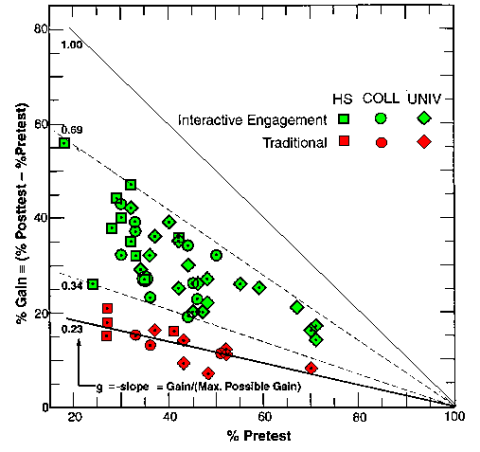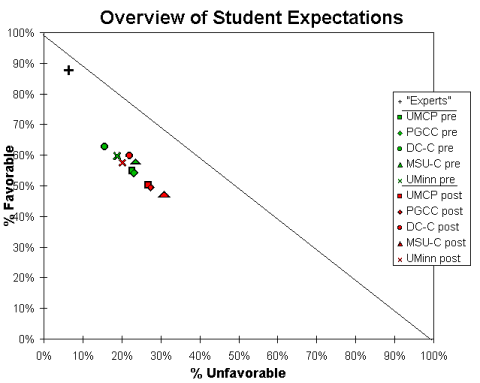
Fig. 1: Results of 62 classes on the FCI. The pretest score is plotted
on the abscissa,
and the gain (post - pre) is plotted on the ordinate. Lines through
the
point (100,0) represent equal values of the fraction of the possible gain.
There has been a major national effort in rethinking education along these lines, with the recent publication of math and science standards providing guidance.[2] But as we reform primary and secondary education, we cannot ignore tertiary education. First, this is the place where primary and secondary teachers are themselves trained, and where technologists receive their training. Second, if we succeed in reforming primary and secondary education, the expectations students bring into their science courses will change. That change will require changes in the way we teach at the tertiary level. Third, even if we grant the unlikely assumption that current primary and secondary reforms are widely effective quickly, it will be years before we have a strong cadre of "new generation" students. In the meantime, as the fraction of people seeking tertiary education and technological training continues to grow, we have to figure out how to teach students with a variety of educational backgrounds.
In this paper, I consider the question:
What must we do to teach physics more effectively in colleges, and universities?
I am neither a cognitive scientist nor an educational specialist, but a physicist studying education within a physics department. Much of the research currently being done on student responses to tertiary education is carried out by a growing cadre of such discipline-based educational researchers. We rely heavily on results from cognitive scientists and education researchers, but we continue to consider ourselves physicists. This group is also responsible for much of the recent growth in the development of research-based university physics curricula.
The recent work done by discipline-based educational researchers has some important consequences. The researchers' primary goal is to illuminate and explain what is happening in tertiary courses. One consequence of this new knowledge is the documentation of the educational cost of either failing to introduce reform or of introducing poorly-considered changes. The results of research also provides guidance for the development of more effective curricula.
Detailed empirical studies confirm these anecdotes. As one example, Hake[3] collected information from 62 introductory high school and college physics courses who used the Force Concept Inventory (FCI) developed by Hestenes et al.[4] The FCI is a qualitative research-based multiple-choice test that probes student understanding of fundamental concepts in Newtonian mechanics. The questions appear simple to a Newtonian thinker, but the distractors agree with what many novices spontaneously believe. Experience suggests that a student who has understood the basic concepts in the first semester of an introductory physics course should score above 80% on this test. The results show that a typical university class may average 40-50% at entry, and students in traditionally taught classes average only about 50-60% at exit. Only about 20% of students typically reach the mastery level.[5] We show a plot of Hake's results in Figure 1.

Fig. 1: Results of 62 classes on the FCI. The pretest score is plotted
on the abscissa,
and the gain (post - pre) is plotted on the ordinate. Lines through
the
point (100,0) represent equal values of the fraction of the possible gain.
The test is given both before (pre) and after (post) instruction. In the plot, the gain (post minus pre) is plotted vertically and the pre-test score horizontally. Straight lines drawn through the (100,0) point represent points of equal fraction of the possible gain, h. Classes having a similar approach tend to produce similar values of h, even if the pre-test scores differ widely. The traditional classes (lecture + cookbook lab) are shown as solid markers. These classes typically produce h on the order of 0.20 plus or minus 0.05, less than 1/4 of the possible gain. The more interactive physics-education-research-based classes discussed below typically achieve twice as large a fraction of the possible gain.
Although it is difficult to summarize 20 years of work in a few lines, the main point is the following:
Students enter their physics courses with learned mental structures that lead to misunderstandings of both the content and process of the material presented. Many of these are discipline specific and need to be dealt with through carefully designed instruction.
Although many detailed difficulties are now documented, only a small fraction of the content of introductory physics has been studied as of this writing. Some aspects of Newtonian mechanics, direct current circuits, and geometrical optics have received careful attention from education researchers. Thermodynamics has been studied extensively, but almost exclusively only with children. Very little work has been published in any other areas of physics learning.
In addition to bringing mental structures into their tertiary education that lead to conceptual difficulties in physics, students also bring incorrect expectations about the nature of the subject. Studies of these issues have only just begun, but preliminary results from studies at Tufts,[9] Maryland,[10] and Arizona[11] may be summarized as follows.
Students often enter their tertiary physics courses with the wrong idea about what they are supposed to do and the nature of the material they are supposed to learn. Traditional courses tend to exacerbate rather than improve this situation. Broadly, good expectations correlate well with student performance in the class.
One probe of student attitudes is our Maryland Physics Expectations (MPEX) Survey. This is a Likert-scale questionnaire of 31 items probing students' attitudes towards the nature of physics and how to do it. Students are asked whether they agree or disagree with each item. For example, three items in the survey are:
To display the results of this survey we introduce an agree-disagree plot. The fraction of responses that agree with the experts' view (referred to as favorable) are plotted on the vertical axis, while the fraction of responses that disagree with the experts' view (referred to as unfavorable) are plotted on the horizontal axis.[12] The average student responses on all 31 survey items is shown in Figure 2. Pre-course surveys are shown as open symbols while post-course results are shown as filled.

Fig. 2: The fraction of students agreeing with experts (favorable)
and disagreeing with experts (unfavorable) on the 31 items of the MPEX Survey,
before (pre)
and after (post) one semester of college physics.
In surveys given at 5 tertiary institutions, only 50-60% of students agreed with expert attitudes before the course. After the course, this deteriorated in almost every case to 40-50%. Agreement with experts on our reality cluster deteriorated as a result of instruction in all institutions studied. These results indicate that traditional tertiary physics instruction not only fails to significantly improve students' understanding of fundamental concepts, it tends to further deteriorate the attitudes they need to succeed.
At the recent International Conference on Undergraduate Physics Education,[15] 20 sample classes developed by discipline-based education specialists for training both teachers and technologists were presented as examples of innovative educational approaches to tertiary physics teaching. Sixteen were strongly grounded in physics education research.
Although there has been an intellectual explosion in physics curriculum development, the actual impact on teaching at the tertiary level has so far been small. Most innovations remain local, ignore the results of physics education research and cognitive science, and are ineffective. Why? I know of no research studies that answer this question, so permit me to switch to speculative mode. Based on personal anecdotal experience, I conjecture:
A significant factor in the resistance of physics faculty to physics education reform are their misconceptions about learning.
One crucial element in these misconceptions is the model of the student and of how students learn that is held by many faculty in physics.
To continue with part 2 of this paper, click here.
[1] John Rigden, "The emergence of the technical workplace and its consequences", in Proc. of the ICUPE, ref. 15.
[2] National Science Education Standards (National Academy Press, Washington DC, 1995); Curriculum and Evaluation Standards for School Mathematics (NCTM, Reston VA, 1989).
[3] Richard R. Hake, "A six-thousand-student survey of mechanics test data for introductory physics courses," Indiana University pre-print, April 1996, to be published.
[4] D. Hestenes, M. Wells and G. Swackhammer, "Force Concept Inventory," The Physics Teacher 30:3 (1992) 141-158.
[5 ]An important point to note is that mastery in the FCI is correlated with but not a guarantee of success in good functional understanding.
[6] Lynn Steen, Calculus for a New Century, A Pump, Not a Filter (Mathematical Association of America, 1988).
[7] Of course, some physics professors do speak Urdu -- but this is a small fraction.
[8] Lillian C. McDermott, "A View from Physics," in Toward a Scientific Practice of Science Education, edited by M. Gardner, et al. (Lawrence Erlbaum Associates, Hillsdale NJ, 1990) 3-30.
[9] David Hammer, "Epistemological beliefs in introductory physics," Cognition and Instruction 12, 151-183, 1994.
[10] E. F. Redish, R. N. Steinberg, and J. M. Saul, "The Distribution and Change of Student Expectations in Introductory Physics", in Proc. of the ICUPE, ref. 15.
[11] I. Halloun, "Views about science and physics achievement: the VASS story",in Proc. of the ICUPE, ref. 15.
[12] Note that the two scores do not add to 100% since some students answer "neutral."
[13] See the sample class descriptions in ref. 15.
[14] E. F. Redish, "New Models of Physics Instruction Based on Physics Education Research", University of Maryland preprint, April 1996, to be published in Proceedings of the Deutsche Physikalische Gesellschaft, Jena Meeting, March 1996.
[15] Proceedings of the International Conference on Undergraduate Physics Education (ICUPE), College Park MD, July 31-Aug. 3, 1996, E. F. Redish and J. S. Rigden, Eds. (AIP, 1997).
 U. of Md. Physics Education Research Group HomePage
U. of Md. Physics Education Research Group HomePage
 U. of Md. Physics Department HomePage
U. of Md. Physics Department HomePage
 U. of Md. HomePage
U. of Md. HomePage